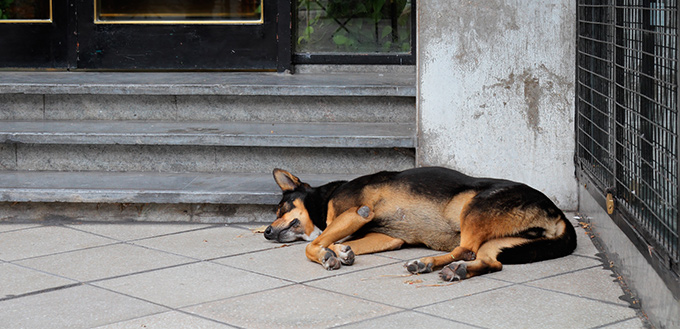Your pet is having a great day at the park. It’s running and jumping and playing with you and the other dogs. Then suddenly it stops on its tracks and falls down on the ground, unable to rise. What’s happening? Rather than go into a panic mode it is best to stay composed and calm. Acute collapse in dogs is quite similar to fainting or syncope in humans. Most dogs recover quickly and resume normal activities as if it never happened. Some, however, stay collapsed until help is rendered. So what is acute collapse in dogs? Is it okay not to worry so much? Here’s what you need to know about this phenomenon in dogs.
Collapse vs. Fainting
Before we proceed to understanding the causes of acute collapse among our canine friends, it is imperative that we differentiate it from another phenomenon that is almost always equated with collapse: fainting.
The main difference between collapsing and fainting or syncope is the loss of consciousness in the latter. This is mostly attributed to a reduction in blood flow to the brain, resulting in decreased level of consciousness. Since the dog is unconscious, it will not have the means to stay upright; hence, it falls or collapses.
Acute collapse, on the other hand, has more to do with the sudden loss of muscle strength such that the dog is fully unable to maintain a standing or sitting position. The dog is fully awake or conscious. What happens is that it is unable to support its weight in a standing position such that it falls to the ground. If the dog is able to sit but not stand, it is known as hind limb collapse. But if the dog stays in a lying position, it is called complete collapse.

Possible Causes
The ability to stand and maintain a certain posture without falling is a function of several body organ systems working synergistically. The brain is constantly receiving signals from receptors in the muscles so that they are maintained at a certain level of tonicity to effect an upright position. Inside the ears are a series of tubes that are filled with fluid – think a carpenter’s level – which also send signals to the brain regarding the body’s sense of balance. Add to this the signals received and transmitted by the eyes to the brain. All of these signals must be integrated by the dog’s brain to make sure that the body is maintained in an upright position.
Since these organs are also dependent on oxygen and nutrients for optimal functioning, the cardiopulmonary system can also play a role in the maintenance of posture. For instance, if nutrients and oxygen are not delivered to the muscles, then it will not be able to maintain its tonicity, thus losing its ability to keep the body upright. The same is true with the brain which is very sensitive to even the slightest fluctuations in blood oxygen levels. This can lead to loss of control of the muscles.
Some of the most likely causes of sudden collapse in dogs can include the following:
- Diseases of the heart
The heart is the pumping organ of the body. It moves blood throughout the rest of the body, supplying it with oxygen and nutrients and removing byproducts for excretion. If blood is not effectively circulated especially to the organs necessary for maintaining posture, collapse is highly possible. Examples of heart diseases that may lead to canine collapse include congenital heart disease, heart worm disease, cardiac arrhythmias, pericardial disease, and acquired valvular heart diseases, among others.
- Health conditions of the blood
Even if the heart is able to function well, there is a problem with the blood itself if it is still possible that oxygen will not really be delivered to cells. This can still lead to a loss or reduction of function, causing collapse. Severe anemia, polycythemia, and leukemia are 3 of the most common blood disorders that can cause collapse. Internal hemorrhage can also cause it.
- Respiratory conditions
Oxygen reaches the blood by way of the lungs. As dogs breathe, they inhale oxygen into the lungs where it diffuses into the blood. If there is any obstruction in the airways, it is also possible that collapse can occur because of the insufficient amount of oxygen reaching the blood and the tissues. Bronchitis, pneumonia, collapsing trachea, pulmonary edema, and swelling or blockage of the throat have the potential to cause collapse in dogs.
- Nervous system diseases
We mentioned above that the brain is what integrates a variety of information related to the maintenance of posture. Any problem in the neural pathways leading to the brain can also lead to canine collapse. Fibrocartilaginous emboli, myasthenia gravis, and intervertebral disk disease have all been implicated in the development of acute collapse.
- Diseases of the musculoskeletal system
Hip dysplasia is one of the most common reasons why dogs suddenly lose balance and fall to the ground. Diseases of the lumbosacral region or the dog’s lower back can also produce hind limb collapse. What makes this cluster of possible causes quite unique is that they are easy to spot since there will always be telltale signs in the weeks or days leading to the collapsing episode. Dogs may be limping or may show difficulty getting up. It may also be hesitant to stand, sit, or jump. These manifestations typically grow worse with the passing of time.
- Acute toxicity and drug overdose
Certain substances can produce sudden weakness which can lead to collapse. These can include xylitol, snake venom, and rat poison, among others. Diabetic dogs receiving insulin are at an increased risk of collapse due to hypoglycemia. This typically results from an unusually high dose of insulin, leading to significant reduction in blood sugar and blood pressure.

What You Should Do in Case Your Dog Suddenly Collapses
In the event that you saw your dog suddenly collapse, don’t panic. It is natural for pet parents to be concerned. However, if you go into panic mode right away, you will not be able to help your pet in a really efficient and effective manner.
Assess if your pet is fully conscious or not. If it is unconscious, check for its heartbeat. Place your hand on the V of its chest if you have a small pet. If you have a large breed, try feeling for the heartbeat at the level of the ribcage where its left elbow would touch the chest if the elbow were flexed. Alternatively, you can also try feeling for its pulse in the groin area while looking for the rise and fall of its abdomen and chest as a sign of breathing.
If you cannot feel any heartbeat or pulse or there are no indications of chest or abdominal movement that would indicate breathing, then prepare to administer chest compressions. If not, bring it immediately to the vet. Make sure to position your pet in a way that its head is slightly lower than the rest of its body to help facilitate the flow of blood to the brain while preventing any fluids present in the oral cavity to enter the lungs.
If your dog is conscious, take note of the circumstances surrounding the episode of collapse such as what your dog was doing at the time, how long the dog remained on the ground, and its reaction immediately after recovering from the collapse. Make sure to jot all of these down so you will have something to tell to your vet should your dog collapse again.
Call your vet and describe what happened. If he asks you to bring your pet, it is best to transport it inside its crate. Dogs that just came out from collapse tend to be disoriented and confused. Some may be aggressive and bite you even though you’re its master.
Treating Dogs that Suddenly Collapsed
Upon arrival at the veterinary clinic, your vet will be asking you about the dog collapse episode. This is where your observations during the episode can come in handy. Your vet will perform a series of clinical assessments to determine the root cause of the acute collapse.
If the cause is because of airway obstruction, then the obstructing object should be removed from your dog’s airways. If the reason is because of poisoning or toxicity, then the administration of an appropriate antidote will suffice. If the issue is related to hypoglycemia, then administering glucose solutions can help.
Generally, IV fluids will be recommended to help expand the volume of blood and aid in stabilizing blood pressure. If the collapse is due to severe anemia, then blood transfusion may have to be ordered.
The treatment is actually dependent on the underlying cause. It is for this reason that you keep handy all pertinent information related to your dog’s episode of collapse.
It is not uncommon for dogs to collapse especially those that are diabetic, have cardiovascular and hematologic problems, or even musculoskeletal problems. Instead of panicking, you should stay calm and check the status of your pet. Bringing it to the clinic for emergency management or for more thorough assessment should be your next move.
Sources:
- Amy Flowers, DVM, Why Is My Dog Falling Down?, WebMD
- Dynamin-1 Associated Exercise-Induced Collapse, College of Veterinary Medicine
- Dr. Justine A. Lee, Dog Fainting: What Causes It and What Should You Do?, Pet Health Network






